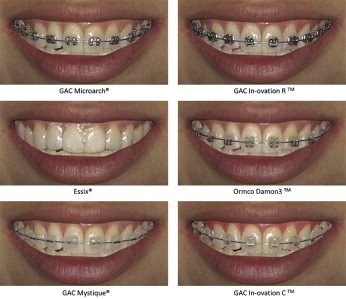Introduction
Although attractiveness and acceptability of orthodontic appliances have been rated by adults for themselves and for adolescents, children and adolescents have not provided any substantial data. The objective of this study was to evaluate preferences and acceptability of orthodontic appliances in children and adolescents.
Methods
Images of orthodontic appliances previously captured and standardized were selected and incorporated into a computer-based survey. Additional images of shaped brackets and colored elastomeric ties, as well as discolored clear elastomeric ties, were captured and incorporated onto existing survey images with Photoshop (Adobe, San Jose, Calif). The survey displayed 12 orthodontic appliance variations to 139 children in 3 age groups: 9 to 11 years (n = 45), 12 to 14 years (n = 49), and 15 to 17 years (n = 45). The subjects rated each image for attractiveness and acceptability. All images were displayed and rated twice to assess rater reliability.
Results
Overall reliability ratings were r = 0.74 for attractiveness and k = 0.66 for acceptability. There were significant differences in bracket attractiveness and acceptability in each age group. The highest-rated appliances were clear aligners, twin brackets with colored ties, and shaped brackets with and without colored ties. Colored elastomeric ties improved attractiveness significantly over brackets without colored ties for children in the 12-to-14 year group. There was a tendency for older subjects to rate clear orthodontic appliances higher than did younger subjects. Ceramic brackets with discolored ties tended to be rated lower than ceramic brackets with new ties and scored lowest in acceptability and attractiveness in all age groups. Girls rated shaped brackets significantly higher than did boys.
Conclusions
Children’s preferences for orthodontic appliances differ by age and sex. Child and adolescent preferences differ from adult preferences.
Editor’s comment
The orthodontic market has experienced phenomenal growth in the development and production of orthodontic appliances that are designed to appeal directly to patients. A shifting paradigm toward dental esthetics, increased demand for orthodontic treatment, consumer-driven desire for esthetic treatment alternatives, and a competitive orthodontic industry have all contributed to the development of alternative orthodontic appliances and new bracket styles. With that in mind, do you know what types of appliances your patients find attractive? The purpose of this study was to determine how children and adolescents perceive the attractiveness and acceptability of a variety of orthodontic appliances. These authors evaluated the overall preferences and compared the interaction of preferences at various ages (9-11, 12-14, and 15-17 years) and between the sexes.
This research was designed as a computer-based survey, incorporating standardized digital images of orthodontic appliances. It was an extension of research projects by Ziuchkovski et al and Rosvall et al, and used some of their previously acquired and standardized images. Subjects were recruited in the college clinics and included any willing child 9 to 17 years old who had never undergone orthodontic treatment with brackets or aligners. All surveys were completed on a laptop computer in the consultation rooms of the orthodontic clinic at Ohio State University.
Major differences in appliance preference were apparent between the age groups. Older subjects had a greater preference for clear appliances than younger subjects. For the 2 youngest groups, all ceramic and hybrid brackets were rated significantly lower than the highest-rated bracket, MicroArch with colored ties. Attractiveness scores for ceramic and hybrid fixed appliances increased in the oldest group and no longer showed a statistical difference from standard twin brackets. Although rated relatively high in the first 2 age groups, clear aligners were not rated significantly higher than the other top bracket choices. However, in the oldest group, clear aligners were preferred significantly over all other brackets. Because children and adolescents are the majority of orthodontic patients, understanding which appliances are acceptable to them will help practitioners meet patients’ needs. It might be reassuring to practitioners that standard stainless steel twin brackets with colored ties, typically the least expensive bracket option and most frequently used by orthodontists, were rated the highest in attractiveness and acceptability among children aged 9 to 14 and the second highest among adolescents aged 15 to 17 years. By providing these brackets, clinicians can meet the desires of over 85% of their patients.





